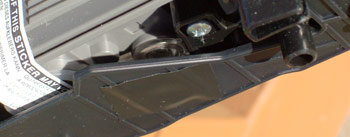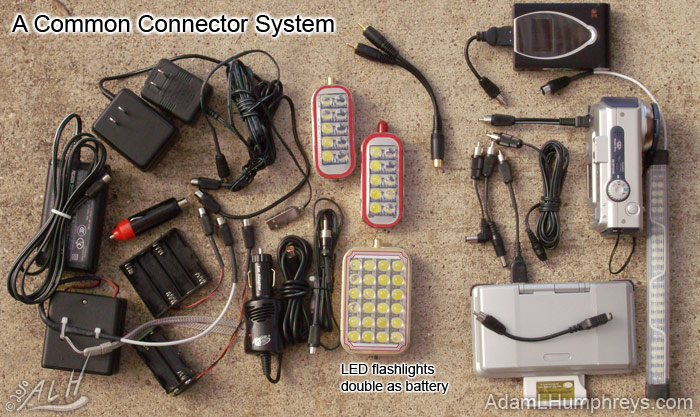Photography and New Media: Perspectives
February 20, 2011As part of my Photography and New Media class, the purpose of these collages is to document a single object or a scene by splicing together images of varying perspectives and distances from more or less the same direction. I call these pieces “My Common Encounters.”

Even though this isn’t my vehicle, this is the one I’ve been using since my vehicle has been in the shop waiting to fixed in order to acquire an inspection sticker. It wouldn’t be a big a part of my life apart from the fact that I usually spend 45 minutes in it 6 times a week.

These light bulbs were part of a project from my Mixed Media class. However, it also represents my lifelong fascination with light bulbs.

This is my desk! As you could imagine, this is where most of my time is spent working on school, my website, things in 3D, watching animation, and just about everything else. The light bulbs are in series on each side, but I still only turn them on when it’s cold.

If you’ve been to my Solar/Wind System page, then it’s easy to figure why these would be a common encounter. I wish I could afford to put more up, but it’s a slow process.
Learn It, Make It
April 11, 2010With so many resources available at the click of a mouse, you can find out how to do just about anything through the Internet. However, it doesn’t replace classic trial and error, and with so many different resources and tools, it’s up to you to determine what’s credible, pertinent, and useful. Many of you already know this, but I want to encourage those of you who haven’t reaped the benefits. If you put your mind to it, you can make something you never thought possible.
So many things, so little time
While there are probably many things you may want to learn, understandably, you likely don’t have enough time to learn them. Simply ask yourself what it is you really want to do or build. Of course, it’s good to keep things practical and in perspective. A nuclear powered house or a jet plane are probably out of reach in terms of time, budget, and legal issues.Possibilities are endless in the digital realm
If you have a computer, making digital content of multiple types has never been so easy, and it should only get easier. With the freeware (and inexpensive software) that’s available today, the possibilities are virtually endless. You could:- develop a website
- compose music
- make a cartoon
- develop a game
- make a comic book
- make a movie
When something isn’t clearly spelled out, do a quick search
Don’t let something you read, or a term you encounter, get the best of you. If you come across a word or phrase you don’t quite understand, look it up and find out what it means. Some documentation will even tell you to do a quick search! Using “Find on this Page” makes things much quicker.One day I determined I wanted to run the freely available “homebrew” programs that people make for the Nintendo DS. There were all kinds of terms and phrases I didn’t understand, but I didn’t let that stop me. Now I can read comics from my Nintendo DS with ComicBookDS.
If you don’t start, you’ll never finish
Sometimes it may seem impossible to do something, even when people around you can do it. But if you set modest goals and take a little bit at a time, you’d be surprised what you can learn to do. If you know nothing about making a website, then making a website is a huge goal. If you make a single web page, you’ll learn how to make a website and then grow from there.When electronics think they’re smarter than you
April 9, 2010Today’s electronic devices have a lot of features, automation, and indicators that are supposed to make things easier. Although most of these things may be well-intended, there are times when I find myself wondering if they weren’t actually designed to fail or make you buy more stuff. “Planned obsolescence” is the term for it. Bottom line: it’s hard to find things built to last that aren’t found in a military surplus store.
Beware of Flaky Sensors and Indicators
There are a lot more sensors incorporated into electronic devices than there used to be. Unfortunately, while some sensors serve a good purpose, many give misleading information. In a some ways, it’s reminiscent of the classic boy who cried wolf.Generally, if you think something is amiss or “fishy,” take a look at it or research the problem. You might be surprised what you find. Rather than give a general description, I’ll give some examples in order to provoke more thought.
My experience with a Brother laser printer
 I like my Brother laser printer. It works great and is always ready when I need it. But, one day, it decided I needed to clean the corona wire because it was “out of toner.” I knew that was not true and found a great page discussing this problem at fixyourownprinter.com Ever since I’ve fooled the sensor, I’ve printed at least 300 sheets and am still using the original toner cartridge!
I like my Brother laser printer. It works great and is always ready when I need it. But, one day, it decided I needed to clean the corona wire because it was “out of toner.” I knew that was not true and found a great page discussing this problem at fixyourownprinter.com Ever since I’ve fooled the sensor, I’ve printed at least 300 sheets and am still using the original toner cartridge!Bad experience with Epson ink-jet printers
My family has also had problems with suicidal Epson ink-jet printers. Our first printer was an Epson, and it worked great for about two years. One day, while it was printing, after it finished printing a nice page without any problems earlier, it gave a “fatal error” code that couldn’t be done away with or reset.Looking up the error code for the printer, we found Epson suggesting the printer be sent in for repair. … Who would do that since printers are so inexpensive? So, we bought another printer and made the mistake of buying another Epson. Can you guess what happened about two years later? … “Fatal error” with no prior indication of a problem. … Foul play (“Planned obsolescence”)?
My experience with the Sony Playstation 2
 I’m sure most people are familiar with the dreaded “disc read error” in many game consoles. Luckily there are many guides out there to fix various game console problems. This is how I acquired my Playstation 2 free, it had this problem. After correcting the problem (a few times), it has worked well for every game I’ve played on it.
I’m sure most people are familiar with the dreaded “disc read error” in many game consoles. Luckily there are many guides out there to fix various game console problems. This is how I acquired my Playstation 2 free, it had this problem. After correcting the problem (a few times), it has worked well for every game I’ve played on it.As I addressed this issue, the thing that confounded me was that the variable resistors that controlled the laser voltage were on the laser head unit itself. As you probably know, the head unit moves around quite a bit, and there was no glue on the resistors to keep them from changing their value.
Trying to follow the circuit layout, it seems like the conductors connecting the resistors don’t even connect directly to anything on the laser head unit! It makes me wonder whether the engineers intentionally choose to put those resistors where things could purposely go wrong, or were they just ignorant.
My experience with an APC UPS
 You can read about my experience with a 400VA APC UPS under the last subhead “Using a Store-bought UPS” in my article about Building a UPS. As it turns out, I recently discovered the point of failure was the cheap relay they used to transfer power. Of course, the unnecessary wear on the relay could have been prevented had the “smart circuits” not wanted to test it every time I turned it on. … If I want to test it, I’ll just unplug it while everything is running.
You can read about my experience with a 400VA APC UPS under the last subhead “Using a Store-bought UPS” in my article about Building a UPS. As it turns out, I recently discovered the point of failure was the cheap relay they used to transfer power. Of course, the unnecessary wear on the relay could have been prevented had the “smart circuits” not wanted to test it every time I turned it on. … If I want to test it, I’ll just unplug it while everything is running.My family’s experience with …
My dad, Lester Humphreys, is an electrical engineer. So it goes without saying that he is the reason I’ve learned so much about electronics. It’s also no surprise how many things we find questionable in terms of design. Most of the time it’s parts made of plastic that should respectably be made of metal.Troubled by “automatic” toilet flushers, sinks, and soap/towel dispensers
There’s not a lot to say here that you probably don’t already know. You’ve probably seen or experienced:- continuously flushing toilets
- the sinks that never work when they should or are always running
- “hands free”dispensers that you practically have to touch
- dispensers that give you as little as possible
- dispensers with dead batteries
Being pestered by car sensors
I’m sure many people have probably had this experience. It seems the newer the car, the more often it’s car horn alarm goes off when it shouldn’t. In my dad’s situation, it’s an occasional “change oil soon” light that can’t comprehend that he uses a longer lasting synthetic motor oil. Additionally, the “fasten seat belt” light comes on when you put a port folio bag in the passenger seat. The seat belt light also intermittently comes on when someone is actually in the seat with the seat belt fastened.In my situation with car sensors, the “air bag” light came on after I had accidentally ran into a tree. … Shouldn’t that light have been on before hitting something? After the oil was changed, the “service engine soon” light stays on for no good reason. The “anti-lock break system” light also stays on, but I suppose I can understand that after hitting a tree. … But why do the blinker lights on the instrument panel stay lit when I turn on my headlights?
Choosing a USB Flash Drive
April 7, 2010Choosing a USB flash drive may seem trivial with only a few things to consider, but there are a few technical details that many people don’t consider or know about. Storage capacity is a given, transfer rates are usually considered, but memory type plays a part in the latter. Also, you may be less likely to forget about your USB flash drive if it has a cap.
Memory type determines speed and longevity
There are two types of non-volatile memory used in today’s USB flash drives and solid state drives (SSD). They are single-level cell (SLC) and multi-level (MLC). Here are some significant differences:| Memory Type | SLC | MLC |
| Cost | more | less |
| Data Density | lower | higher |
| Write Speed | faster | slower |
| Endurance | 100k write cycles | 10k write cycles |
I didn’t compare read speeds because they’re fairly comparable. Also, even though MLC has fewer write cycles, as a consumer, there’s not much chance you’ll have any problems. If you plan to have a server with an SSD, I would opt for SLC memory. You can find more details here:

Having a cap may help you remember your flash drive
It may be convenient and stylish to have a USB flash drive without a cap that slides in or flips out. However, if you need to use a USB port on the back of a computer or otherwise out of sight, it can be easy to forget. If you have a cap, you can place it in an obvious location near your hand or keyboard. When you see the cap, you remember your flash drive.There are many ways to remember your flash drive, but I found this seems to work best for me.
The Problems with “Christianity”
April 6, 2010Most of you probably already know I’m a Christian, but I know there is a growing number of people that may wonder why anyone would want to be a Christian. There is a definite distinction between Biblical Christianity and the generic “Christianity” that dominates society. This causes so many to turn to agnosticism or atheism. Too many take a blind leap of faith into any category, whether it’s a modern day denomination, agnosticism, or atheism.
Doesn’t God and Christianity cause confusion?
There are some today who argue that the world would be better without God, Christianity, or religion. The reasoning behind this thought process generally results from the confusion and hypocrisy they observe in so many denominational churches that exist today. While that reasoning seems good, it’s severely flawed. Examining a derivative or a denomination is not examining the standard, that is, the Bible.God is not the author of confusion (1 Corinthians 14:26-33). However, some claim that because He confused the languages at the tower of Babel (Genesis 11:1-4), that He is the author of confusion. By doing so, they fail to understand that the context of 1 Corinthians 14 refers to confusion concerning speaking order, and more general, the order of the assembly. Also, those building the tower of Babel were apparently already confused about God’s initial command to “fill the earth” (Genesis 9:1), by trying to “make a name for [their]selves, lest [they] be scattered abroad over the face of the whole earth,” (Genesis 11:4). (See Apologetics Press for more details.)
Mankind is indeed the author of all doctrinal confusion today. It seems the reasons are as numerous as the denominations existing today. Taking things out of context is the biggest problem. Men authored the contradicting creed books and commentaries that exist today, not God.
Some contend that men wrote the Bible, but God wrote through men (2 Timothy 3:16). With the Bible’s scientific foreknowledge, historical accuracy, and available manuscripts, there’s no good reason to doubt it’s divine origin. A great deal more could be said about the Bible’s authenticity, but not within the scope of this article.
People Pick and Choose
Many people want to believe what they like and remain willfully ignorant of what they don’t like regardless of its source or credibility. It’s preferable to look at the shiny side of a dirty coin. The children of Israel rejected knowledge many times from the Old Testament to the New (Hosea 4:6).While people like to believe in things like faith only, purgatory, and miracles today, among many other things, they have no Biblical basis. People like to ignore the Biblical truth concerning marriage, divorce, remarriage, homosexuality, alcohol, and many other things explicitly discussed in the Bible. One group says one thing while another group says another, everyone teaching what they believe without consulting the Bible. As a result, people conclude, “wouldn’t we be better without God,” without knowing the Bible in its fullness, if at all.
Unfortunately, there are some genuine Christians out there who are unfaithful, causing reproach on the church. (1 Peter 1:13-16, 1 Peter 2:11-12) If you’re someone outside of Christ’s church, you can’t properly judge the church using an erroneous sample or too small of a sample.
What about Bible contradictions?
The Bible has many critics. In most situations, people want to disregard it because they don’t like the idea of being held accountable for their actions in this life or they do not desire to live a proper righteous life. Nevertheless, the Bible has stood the test of time, and you can find answers to most of the alleged contradictions and discrepancies at Apologetics Press - Alleged Discrepancies.There’s a big difference in simply reading the Bible and understanding the Bible. This is not to say that the Bible is difficult to understand. In many cases, people are usually given “help” to misunderstand it. Unfortunately, there is much of that “help” out in the world today.
I like to take an objective view of everything, including the Bible. There are too many people that make decisions based on something they “feel in their heart.” Although I understand that few would agree with the Bible, I’d have more respect for an agnostic or a “Christian” (with a blind faith not based on the Bible) seeking the truth, than an atheist.
Why I prefer Cinema 4D over Maya
April 3, 2010If you plan to develop something in 3D, maybe you’ve wondered what software package would be the best for you, (unless you plan to develop your own and reinvent the wheel). Some of you may already know that I have a preference for Cinema 4D, but I would like to discuss why. That doesn’t mean I necessarily mandate Cinema 4D to be “better” than Maya, it really depends on your needs or preference.
Which is more efficient at rendering?
In the 2008 fall semester at Collin College, I decided to try an experiment. I rendered a turntable of my final character project and a flythrough of my environment project. (See the projects in my 3D Modeling and Rendering II gallery.)I used both Maya 2008 (Mental Ray) and Cinema 4D 10 with a near identical scene setup for the turntable. I tried a few different settings for the turntable in each software package, but the results were virtually similar.
For the flythrough in Cinema 4D, I included my character lying on the bed since I hadn’t imported it into Maya. Notice that I also used a slower computer for the flythrough render in Cinema 4D. This wasn’t intentional, I simply didn’t have the opportunity to use the school’s faster computer.
Each computer had 3GB of memory. The render resolution was 720x486.
| Animation | Animation Length | Computer Speed | Software | Render Time |
| Turntable | 8 seconds | 8 cores @ 2.0GHz | Maya | 1 hour |
| Turntable | 8 seconds | 8 cores @ 2.0GHz | Cinema 4D | 7 minutes |
| Flythrough | 16 seconds | 8 cores @ 2.0GHz | Maya | 1.5 hours |
| Flythrough | 16 seconds | 2 cores @ 2.4GHz | Cinema 4D | 20 minutes |
Please note that I didn’t use anything special like global illumination in these renders. Also, Cinema 4D has actually doubled its own render time in version 11.5, whether using things like global illumination or not. Unfortunately I still only have version 10 as of this writing.
I was first introduced to Maya in spring 2006 at Collin College. Render time was one of the first things I wondered about. Why did it take so long to render something on a computer that’s faster than mine? I thought it may have been the network or background tasks, but running Cinema 4D from my USB drive still outperformed Maya. If you think something was completely amiss concerning this test, please tell me what was wrong and/or suggest some settings I should use.
What about workflow?
Workflow is really a matter of preference. I’ve heard people say Cinema 4D is good for learning, but I have to ask, why stop there? I think I can understand why it would be easier to lean Cinema 4D. It has an intuitive and well organized interface which is also highly customizable.Maya’s interface seems slightly more cryptic but basic tasks are still easily understood. Unless you understand what the terms mean, you could get lost. If you’re used to it, there’s no problem.
In another note, I think Blender 3D would dominate if it had a customizable interface so people that like to be flexible with other software could actually use it along with the others. I know there’s a few people that tout Blender’s interface, but it’s worthy to note that not everyone works the same way. What’s efficient to one person may not be efficient to another who has equally tried several methods.
What about the bugs?
On a few occasions I have had Cinema 4D crash on me. It gives me a notification and usually saves a copy of my open file in an error report folder. As a result, I usually don’t loose any work. There are occasions where the saved error file is understandably corrupt, but I have never had any problems with other saved files being corrupt.Unfortunately, I have heard much worse things about Maya from classmates and instructors at Collin College and in UTD’s ATEC department. Instructors always seem to warn about Maya crashing and corrupting files. I also hear of complaints about bugs with new releases of Maya and instructors suggest using a version below the latest.
The only other problem I’ve seen with Cinema 4D is crashing while using OpenGL on a computer it wasn’t installed on (i.e. running from my USB drive). Once I disable it however, there isn’t a problem.
What about scripting?
Scripting is probably what makes Maya attractive, especially because it uses Python. Scripting is essential when it comes to game development. Cinema 4D has scripting using COFFEE and Xpresso which aren’t really common at all. However, like Maya and many others, it also comes with an SDK that uses C/C++.Is Autodesk the standard?
Metaphorically scratching my head, I couldn’t help but wonder why Maya is considered an industry standard. Asking a fellow student in my small business class, who does architectural work with AutoCAD, said because it’s Autodesk. He likewise voiced his grievances and frustration with buggy Autodesk software.I suppose I could liken Autodesk to Microsoft, but I have to give Microsoft credit. Microsoft realizes it has real competition in the corporate world whereas Autodesk doesn’t truly seem to notice. People use their products because companies use their products. However, even Adobe keeps a pretty high standard for their software quality.
Anthropomorphic Character Modesty (1 of 2)
March 27, 2010In our normal world, there is a general standard where humans wear clothing and animals don’t. In the world of art and animation however, we mix the two in the form of anthropomorphic characters, and this complicates things. When does it become necessary to draw the line with clothing and modesty? Let’s examine this prior to a survey I wish to conduct.
Does it matter?
It’s likely that most artists don’t closely consider or even care whether what they present is modest or immodest. But if you’re targeting a mass audience, it becomes necessary to address this issue. It’s also likely that most people don’t care, but you need to consider your specific audience. As a Christian according to the New Testament and as an artist, I must be particularly aware.Whether you’re a Christian artist/viewer or not, you likely have standards. But those standards are for humans, so anthropomorphic characters can be ambiguously sticky.
What are modesty and immodesty?
Before we can assess what’s “modest” and what’s “immodest” we need to know what they mean. Here are some definitions for modest:- the Free Online Dictionary, Thesaurus and Encyclopedia: Modest
- Dictionary.com: Modest
- An American Dictionary of the English Language (Volume 2; New York: S. Converse, 1828), by Noah Webster
- the Free Online Dictionary, Thesaurus and Encyclopedia: Immodest
- Dictionary.com: Immodest
- An American Dictionary of the English Language (Volume 1; New York: S. Converse, 1828), by Noah Webster
- “disinclination to call attention to oneself”
- “conventional proprieties”
- “free from showiness or ostentation”
- “having or showing regard for the decencies of behavior, speech, dress, etc.”
- “offending against sexual mores in conduct or appearance”
- “indecent”
- “shameless”
- “unchaste”
- “lewd”
- “obscene”
- “arrogant”
What makes an anthropomorphic character modest or immodest?
Animals don’t wear clothing and are generally modest. However, as an artist adds more human characteristics, we naturally perceive it more like a human. Therefore it becomes necessary to add clothing.And vice versa, when the character is more animal like, clothing may be unnecessary if no “sexy bits” are present. Clothing may even distract the viewer from the main point of the subject matter. An unclothed character more animal-like than human-like isn’t generally lewd assuming the subject matter isn’t lewd.
Unfortunately, what makes a character modest or immodest is not only dependent on an artist’s presentation, but a viewer’s perception. Therefore, it becomes necessary to know the average viewer’s perception. The keyword is “average,” there are always exceptions. Some won’t find anything particularly immodest while some will find practically everything immodest.
There’s always some out there who will perverse
If you’re an artist that’s concerned about what you present, don’t beat yourself up when things seem to go awry. Even if you actually left nothing to misinterpretation, some people can still find a way to pervert it. Your work will sometimes be criticized and taken out of context.Consider that even God’s work, the perfect Author and Artist, is sadly misrepresented all the time. Concerning modesty and clothing (for humans), these are Biblical standards I adhere to (see context for details):
- Exodus 20:26 - “Nor shall you go up by steps to My altar, that your nakedness may not be exposed on it.”
- Exodus 28:42 - “And you shall make for them linen trousers to cover their nakedness; they shall reach from the waist to the thighs.”
- Isaiah 47:1-3 - “Uncover the thigh, Pass through the rivers. Your nakedness shall be uncovered, Yes, your shame will be seen;”
- Nahum 3:5 - “I will lift your skirts over your face, I will show the nations your nakedness, And the kingdoms your shame.”
- Matthew 5:28 - “But I say to you that whoever looks at a woman to lust for her has already committed adultery with her in his heart.”
- 1 Corinthians 6:19 - “Or do you not know that your body is the temple of the Holy Spirit who is in you, whom you have from God, and you are not your own?”
- 1 Timothy 2:9 - “In like manner also, that the women adorn themselves in modest apparel, with propriety and moderation, not with braided hair or gold or pearls or costly clothing,”
Adding batteries to your devices
March 24, 2010Whether you’re on vacation taking pictures and video or working on your laptop in the park, extended battery life can be a big help. Maybe you’ve lost or had a cell phone charger die and wondered if you could use an old one of the same voltage if it had the same connector. Adding more battery power or adapting connectors gives you a lot of flexibility. If you do it yourself, you may find it’s very inexpensive.
Develop a Common Connector System for Your Devices
Before you can add batteries to a device, you need to be able to connect them. I know “universal connectors” exist, but there are still plenty of devices that use special connectors. A simple solution is to splice into the cord and add RCA in-line connectors. I recommend using male plugs for the device connector and female jacks for the power source with a positive center and outer negative shield.In-line RCA female jack connectors aren’t as common as male plugs, but they’re still inexpensive compared to other connectors. Here’s a few places to get them:
- Alltronics: Audio Connectors
- Minute Man Electronics: Female In-Line RCA Jacks
- HomeTech Solutions: RCA Female In-Line Jack

Where can I get battery holders?
- BatterySpace.com: Battery Holders/ Racks
- Radio Shack (locally or online)
- Newark.com: Battery Holders
- Amazon.com: Battery Holders
How many batteries do I need?
If you match the capacity, Ah or mAh (milliamp hours), of the existing batteries with that of the added batteries, then you’ll nearly double its operating time. But, you can have as many milliamp hours as you want wiring batteries in parallel. The important thing to remember is to match the voltage of the device’s power supply.If the device uses a transformer, use a multimeter to measure the actual device’s power supply output voltage when it’s connected to the device. A transformers’ output voltage is usually higher when disconnected while the specified output can be lower.
NiMH (and NiCd) battery cells (a single AAA, AA, C, D, etc.) are 1.2V per cell (nominal voltage). When charged, the cells are 1.4V. (Li-ion cells are 3.6V nominal and 4.2V charged.) If your device uses 5V, then you would need 4 NiMH batteries in series for 4.8V (5.6V charged). Most laptops use 19.2V from their power supply, so that would be 16 NiMH batteries in series.
What battery type should I use?
If you plan to extend the battery life of a device, a good choice is NiMH because of its availability and flexibility. Nearly every battery pack used in today’s devices use one of three types of chemistries:- NiCd (Nickel Cadmium)
- NiMH (Nickel Metal Hydride)
- Li-ion/Li-polymer/LiFe (Lithium Ion/Polymer/Iron Phosphate)
Make Your Own UPS
March 19, 2010Before uninterruptible power supplies (UPS) were made as a single unit, people had to make one with batteries, an inverter, and a charger. There are still advantages to doing this, like expandability and knowing how it will react to a situation. If you consider yourself an electronic hobbyist, you may find this is a fairly simple project.
Choosing Your UPS Type
The table below shows the basic differences between two major types of UPSs. The parts listed would be used for a UPS lasting about 15 minutes putting out 400W. If you can find them less expensive or want a different brand, go for it! If you want more power or a longer time, use a bigger battery, inverter, or charger accordingly.| Standby/Line interactive | Online | |
| What it does | maintains battery charge; it switches to the inverter powered by the battery during an outage | a charger powers the battery and inverter; it stops charging during an outage while the battery continues to power the inverter |
| Cost | less | more (the charger) |
| Complexity | more (the relay switch) | less |
| Power usage | less (small float charger) | more (charger and inverter; heat loss due to conversion inefficiencies) |
| Noise | less (fan on inverter during outage) | more (fans on the charger and inverter) |
| Parts list |
|
|
Putting it Together
Regardless of what UPS you’re building, you will inevitably wire the battery, the output of the charger, and the input of the inverter in parallel. That means all the black negative wires go together and all the red positive wires go together. You’ll need large wire to handle the current. Only the small float charger will use smaller wire.Setting up the Online UPS
Once you’ve wired everything in parallel, you’re done! Just plug in the charger into an outlet and plug in your equipment into the inverter outlet. If the battery is charged, unplug the charger and make sure it works.Building the Switch Box for the Standby UPS
The Schematic

If you’re not an electronic hobbyist, don’t let the diagram scare you too much, just follow it. The relay I suggested should have it’s own diagram on the top cover. The packaging of most relays indicate what pin number on the schematic corresponds to the pin number on the relay itself. Just match up their schematic with the schematic above. It should be very similar.
See “How it Works” below for an explanation of what “NC” and “NO” means.
For you electronic hobbyists, you know most relays use 12VDC. If you can’t find a relay that has a 125VAC coil like the one I listed, use a small 12V transformer and rectify the output to DC (or use an unused cell phone charger). Don’t use a capacitor! This would cause a delay in the relay switching time.
Putting it in the Box
Place everything in the box however you like, or at least in a way that isn’t obviously hazardous. If you have cords going out of drilled holes, make sure you smooth the edges of those holes. Tie knots into the cords inside the box so they can’t be pulled out. I used IEC connectors myself, check out my box (in the lower right hand corner).Connections to the relay should be soldered. Also make sure those connections can’t sort against the box if it’s metal. If it is loose in the box, cover it with electrical tape.
If you’re real cheap, you could just run cords (plugs and an extension cord end) directly to and from the relay and tape it up. … Not that I would recommend that. I like things to look neat.
Setting up the Standby UPS
- Make sure you’ve already wired the battery, charger, and inverter in parallel.
- Plug in your switch box line input into a wall outlet or power strip. The relay should click.
- Plug in your switch box inverter input into the inverter.
- Plug in your equipment into the power output of your switch box.
- Test it by unplugging your switch box from the wall, or switch off the power strip.
How it Works
The switch box works by using a relay to switch AC line power to inverter power when the line is off (outage). When line power is on, the relay is on. The relay closes it’s contacts that are normally open (NO), causing the line power to pass through to the socket and the equipment plugged into it.When the relay is off (loses it’s power from the line), the normally closed (NC) contacts are closed, and now power from the inverter powers your equipment.
Since this isn’t a “real” UPS, it doesn’t synchronize it’s output frequency with that of the line. If you plan to use it with a computer and monitor, which usually rectify their input to DC anyway, it shouldn’t really matter too much. I’ve never had any problems.
Using a Store-bought UPS
You might be able to buy a good UPS, but my experience is limited in this area. I’ve only had a 400VA APC UPS. It worked great for a while and it always seemed to test the battery when you turned it on. But it would always switch to the battery and back to the line when I turned my printer on.A year or so later, the APC UPS decided to just turn my computer off when I turned my printer on, failing to do its job. It wasn’t the battery because I continue to use the same battery for my own standby UPS. At some point, it just turned my computer off at random. The “cure” was now worse than the “disease” and intolerable. (UPDATE: It turned out to be the cheap relay. Read my article When electronics think they’re smarter than you for details.)
This doesn’t mean you can’t buy a good UPS, I just don’t know where. I didn’t get another one because I already had a good battery (which is a large part of the price). All in all, it seemed like the APC UPS was trying to protect itself more than the equipment that was plugged into it–too many stupid “smart” circuits.
Let’s go camping with solar
March 17, 2010Let us consider a possible scenario. You want to go camping and want to use solar power to charge a 12V battery connected to a 120VAC inverter to power your stuff. Calculating battery size and solar panel power is important if you don’t want to be left without power. Amp hours (Ah) work much the same way as watt hours (Wh). Multiply battery voltage times the Ah rating and you get Wh (more or less), but there are also other things to consider.
Let’s setup a possible scenario
Let’s say you would like to take a primitive camping trip. You want to make sure you have enough power to occasionally run your laptop and charge batteries for your camera. You would like to run your laptop for 4 hours a day and charge 4 AA NiMH batteries a day. Let’s also assume you’ll be gone for 5 days.As we go through this scenario, keep in mind that this same deductive reasoning can be applied to many different scenarios. Maybe you want to power:
- something during an outage
- your RV’s appliances
- your laptop through a 14 hour flight using a few parallel sets of 16 NiMH batteries in series
- a remote pond water pump
- Battery-Web.com - Frequently Asked Questions (FAQ) (see last question)
- Effects of Discharge Rate and Temperature on Battery Capacity and Life - Engineers Edge
- Sealed Lead Acid Battery Applications - Transwiki
- GB Industrial Battery - AH Ratings: 6hr rate vs 20hr rate
- Battery Performance Characteristics - How to specify and test a battery






